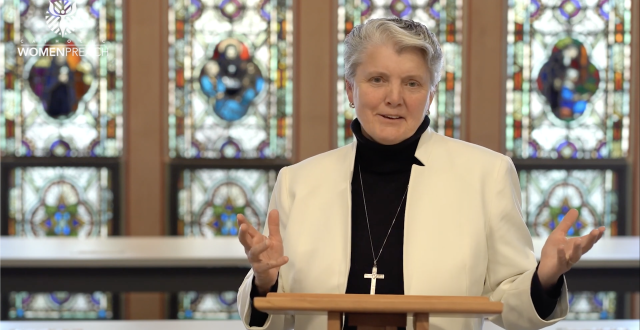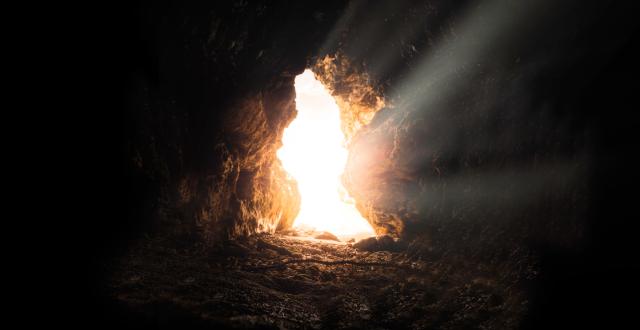By Barbara Quinn, RSCJ
Death is not a particularly appealing topic. For understandable reasons, we shy away, even run away, from its reality. Ernest Becker signaled our refusal to acknowledge our own mortality in his 1974 Pulitzer Prize winning book, The Denial of Death, a work that continues to hold great relevance 40 years later. Our amnesiac, numbing tactics show up even now with Botox and age defying miracle drugs and the red sports car syndrome of the proverbial mid-life crisis! But of course, one might protest! The tomb is dark and cold, lonely and frightening, even for the brave and the realistic. As Woody Allen quipped, “I am not overly afraid of death. I’m just not eager to be there when it happens.”
Nonetheless, the Scriptures for the Fifth Sunday of Lent look death right in the eye and they ask us to do the same. Actually, attention to death and all the levels of dying and brokenness that precede it has been gaining momentum over the past couple of Lenten Sundays. The woman at the well is a story of personal restoration from the dead end worship of false gods. Last week, we looked on as the beggar was healed of his blindness and the death dealing social sins of the neighbors, the Jews, and the parents were exposed as they chose belief in the darkness rather than celebrating the new light of day now enjoyed by the beggar man. And this week, we meet the cosmic brokenness of all creation epitomized in death itself. The ultimate, final chapter of life closes on Lazarus and Mary and Martha wail in protest that Jesus could have saved their brother if only Jesus had been with them!
And here the mystery begins to unfold. Jesus was not indifferent to the pain and heartbreak of death. “He wept” and was “perturbed and deeply troubled.” But he professes a deeper reality: “I am the resurrection and the life; whoever believes in me, even if they die, will live, and everyone who lives and believes in my will never die. Do you believe this?”
It all seems so elusive! Where do we begin to make sense of such profound mystery? The good news is that when we search the life, legacy, and prayer of great friends of God in the Christian tradition, we discover uncommon wisdom to help us understand even the starkest realities of life in a new and deeper way. This is the stuff of hope. John of the Cross, the sixteenth century Carmelite mystic, arrived at profound insight about God’s mysterious way of working in our lives, especially in times of bewildering darkness. He is one of the wisest teachers about the mystery of suffering (see The Impact of God: Soundings From John of the Cross by Iain Matthew) and the mysterious treasure suffering, even death, can hold!
Here is a saint, a doctor of the Church, who was imprisoned by his own Carmelite brothers because he pressed for reforms within the Carmelite way of life. Many of the Carmelites, both men and women, had lost the edge, the crispness, of a radical way of life. Now John challenged them to be “discalced,” that is, without sandals; to send their maids and servants home in order to return to a more simple way of life; to enter more deeply into prayer as they promised they would. John’s brothers gave “push back” new meaning! They kidnapped him and threw him into prison. They beat him and taunted him by telling him that his life work was of no use. They served him putrid food laced with lice and forced him to live for months in something akin to a closet with one small opening…until the night when he escaped. It was precisely during that torturous time that he wrote his exquisite poem, “Dark Night.” “Oh dark night, more certain than the dawn ...”
Even at the end of his life, he was silenced and sidelined, shunned and libeled. He, this persona non gratis, was essentially dead. The superiors ill-treated him as he lay dying until someone finally took mercy and cared for him with a modicum of humanity. Wouldn’t such treatment be enough to cause any one to reject the very Gospel tradition they espoused and cultivated throughout their adult lives? Wouldn’t this be enough reason to give up hope and reject Jesus’ proclamation, “I am the resurrection and the life?” But what John learned through these death dealing experiences was something different. He learned that in the very moments when we feel most helpless, vulnerable, afraid, inadequate, and diminished, some kind of space opens up for God to teach us God’s perspective on life. God’s wisdom, “O dark night…as certain as the dawn …”
Great souls, poets, philosophers, and contemplatives all understand this. Leon Bloy wrote: “There are places in the human heart which do not yet exist. Suffering enters into them so that they might have existence.” Theodore Roethke says something of the same: “In dark times, the eyes begin to see.”
You see, in the end, the mystery of death and resurrection is a religious experience more than a theological problem to be solved. The rising that overcomes death is not finalized when our bodies are raised but when the spirit of Jesus dwells within us and all creation – even now! Paul tells us today in his letter to the Romans: “If the Spirit of the One who raised Jesus from the dead dwells in you, the One who raised Christ from the dead will give life to your mortal bodies also through the Spirit dwelling in you.” Even now! How blessed were Lazarus, Martha and Mary as they saw the glory of God in the miraculous raising of this many from Bethany. But they came to see even more deeply that God’s power overcomes our daily dyings and gives way to a resurrection of hope, wisdom, and deeper friendship with God - even now.
In Christ, we are transformed personally, socially, cosmically. There is always deeper life and new hope, even in suffering and death, if we know how to see. Go look!
“Earth’s crammed with heaven,And every common bush afire with God;But only (those) who see, takes off (their) shoes – The rest sit round it and pluck blackberries.” ~ Elizabeth Barrett Browning



